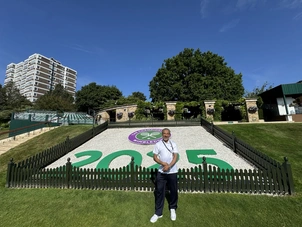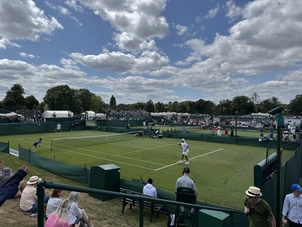
What’s a typical day like at Wimbledon?
I’m on-site from around 8am as many players need treatment before matches start at 10am. That could be anything from treating injuries to managing a split nail or a painful blister. The key is quick, effective intervention. Players often have another match within hours, or the next day, so providing fast assessment, treatment and pain reduction is essential.
On rainy days, it gets hectic. Only Centre Court and Court 1 have roofs, so delays pile up on other courts. That means we’re often working into the evening — sometimes as late as 11pm. It's long hours, and no, we don’t get to watch the matches!
You also support players during qualifiers. How does that differ?
At the qualifiers, you’re often working with younger, less experienced players, many who don’t have access to regular medical support. For some, it’s their first time seeing a podiatrist! They’re incredibly grateful for the care, and we can often spot issues that no one else has picked up before, so it’s very rewarding.
How does the grass surface affect injuries?
Grass is a much softer playing surface than the hard courts or clay which players are generally used to. The change in surface means that players experience more slipping, more foot movement within their shoes and the result is more chance of sprains, twists, and blisters. Players wear special grass-court shoes, but even so, the risk of foot-related injuries is higher on grass.
Biomechanically, the surface gives less feedback and firmness, so any existing weaknesses in the leg or spine can be aggravated. It’s a beautiful surface for tennis but it’s tough on the body.
Are you involved in injury prevention too?
Absolutely. We screen players before matches to assess biomechanics, foot structure, and footwear. If someone has flat feet or a high arch, for example, we can make semi-bespoke orthotics that support them through the tournament.
Many players have their own orthotics, but different surfaces require different support. We have all the materials on-site to adjust them on the spot to improve shock absorption, alignment, and stability depending on the court and shoe.
What podiatry advice would you give to amateur tennis players?
It would be really great to go get a full biomechanical screen to make sure your shoes fit properly. This is because footwear that's too small can cause toenail injuries; and footwear that’s too large is just asking for blisters and calluses. You’d be surprised how many injuries are down to ill-fitting shoes.
Also, just like we tell the pros, it’s important not to remove all the callus on your feet. A little bit of callus is natural — it’s the body’s way of protecting against friction. I’ve seen cases where removing too much has caused soreness mid-tournament. It’s about balance.
And finally, rehab is key. It's not just about recovery — it's about building strength and preventing future injuries.
What are your top tips for dealing with blisters and nail trauma?
If a blister is new and painful (within the first 24 hours), it should be lanced, drained, and dressed using sterile techniques, ideally by a professional like myself. If it's been there longer and isn't painful, I’d advise the patient to protect it with dressings to keep it clean and sterile.
For toenails, always cut them straight across, never down the sides! It might feel better temporarily, but it can encourage the nail to grow inward. A badly managed toenail can quickly turn septic and in the case of the players it can even end their tournament.

Podiatry at The London Clinic
At The London Clinic, Saj brings the same expertise he uses on the tennis athletes to a broad range of patients, from marathon runners to those recovering from surgery or dealing with complex health conditions. Working within a Multidisciplinary Team (MDT) alongside spine surgeons, vascular specialists, rheumatologists, and endocrinologists, he helps manage everything from sports injuries to diabetic foot complications.
“We see patients with scoliosis, arthritis and nail damage as a result of chemotherapy, and podiatry plays a crucial role,” Saj explains. “By correcting alignment or reducing pressure through bespoke orthotics, we can often reduce pain, delay surgery, or help avoid it entirely. Custom made orthotics can also help enhance recovery post back and spinal surgery.”
Learn more about our Podiatry Services at The London Clinic and how we can support your health from the ground up.

